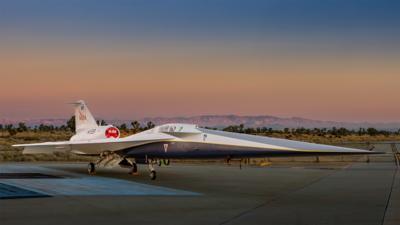Mon, Jan 15, 2024
New Supersonic Prototype Aims to Soften the Blow When Going Beyond Mach 1
No more CGI for the next-gen x-plane from NASA and Lockheed Martin now that the duo has finally debuted the quiet supersonic aircraft live in the metal.

The X-59 Quesst aircraft is a demonstrator to bear out the possibility of supersonic flight without the sonic booms. If successful, the concept will revolutionize public air travel with a whole new niche of high-flying, fast-moving, supersonic aircraft. The Concorde took a swing at the supersonic passenger craft idea, but it ultimately died a slow, expensive market death as its destinations limited its performance to reduce noise on the ground. That apparently ended supersonic pax carriage for good, but new money, new ideas, and fresh materials lie ready and waiting to take another crack at the market.
“This is a major accomplishment made possible only through the hard work and ingenuity from NASA and the entire X-59 team,” said NASA Deputy Administrator Pam Melroy. “In just a few short years we’ve gone from an ambitious concept to reality. NASA’s X-59 will help change the way we travel, bringing us closer together in much less time.”
Melroy was joined by brass from Lockheed and NASA at a ceremony revealing the Quesst demonstrator at the former's Skunk Works facility in Palmdale, California. The aircraft, if successful, won't necessarily be completely free of sonic booms, however. NASA wants to reduce the effect of the supersonic crack with sculpting, shaping, and materials placement that will slough off and delay the transition to supersonic along the body of the aircraft. If successful, the Quesst demonstrator will hit its supersonic cruise of 925 mph or 1.4 mach with a quiet "thump" instead of a loud "boom".
“It’s thrilling to consider the level of ambition behind Quesst and its potential benefits,” said Bob Pearce, associate administrator for aeronautics research at NASA Headquarters in Washington. “NASA will share the data and technology we generate from this one-of-a-kind mission with regulators and with industry. By demonstrating the possibility of quiet commercial supersonic travel over land, we seek to open new commercial markets for U.S. companies and benefit travelers around the world.”
More News
How To Get A Story On Aero-TV News/Feature Programming How do I submit a story idea or lead to Aero-TV? If you would like to submit a story idea or lead, please contact Jim Campbel>[...]
From 2011 (YouTube Edition): Aviation's Greatest Living Legend Talks About His Life In Aviation (Part 5, Final) ANN is pleased to offer you yet another snippet from the public conv>[...]
“All Air Traffic Controllers must get back to work, NOW!!! Anyone who doesn’t will be substantially ‘docked. For those Air Traffic Controllers who were GREAT PATR>[...]
Aero Linx: American Navion Society Welcome to the American Navion Society. Your society is here to support the Navion community. We are your source of technical and operating infor>[...]
Glideslope Intercept Altitude The published minimum altitude to intercept the glideslope in the intermediate segment of an instrument approach. Government charts use the lightning >[...]
 ANN FAQ: Contributing To Aero-TV
ANN FAQ: Contributing To Aero-TV Classic Aero-TV: Bob Hoover At Airventure -- Flight Test and Military Service
Classic Aero-TV: Bob Hoover At Airventure -- Flight Test and Military Service Aero-News: Quote of the Day (11.12.25)
Aero-News: Quote of the Day (11.12.25) ANN's Daily Aero-Linx (11.12.25)
ANN's Daily Aero-Linx (11.12.25) ANN's Daily Aero-Term (11.12.25): Glideslope Intercept Altitude
ANN's Daily Aero-Term (11.12.25): Glideslope Intercept Altitude



